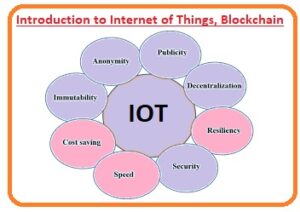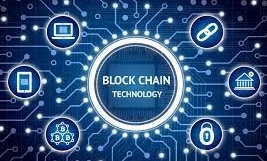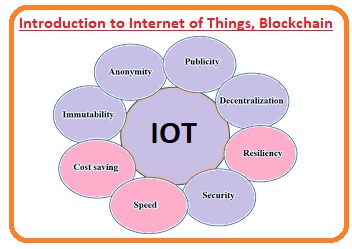 Hello, readers welcome to the new post. In this post, we will have a detailed look at Introduction to Internet of Things. Understanding the Internet of Things is becoming more and more crucial for professionals as it expands quickly.
Hello, readers welcome to the new post. In this post, we will have a detailed look at Introduction to Internet of Things. Understanding the Internet of Things is becoming more and more crucial for professionals as it expands quickly.
Many individuals are unaware of the true meaning of IoT (Internet of Things), the IoT platform, and how it may be applied to enhance company tactics.
. Now what exactly is Internet of Things?
The Internet of Things is a natural system of connected hardware devices that are easily accessible using the Internet. The ‘object’ IOT can be smartwatches or devices having inbuilt sensors which computer-based hardware connected for gathering and data transmission through the network without the use of any aided devices
. Integrated technology in devices enables them to adapt to internal conditions or external environments, which in turn influence decisions. So let get started Introduction to the Internet of Things
Introduction to Internet of Things
- The online object system consists of four elements: sensors / devices, communication, data processing, user interface.
- Sensors: Collects external data from devices and transmits data to the cloud.
- Devices Connectivity: All devices have the ability to connect with the cloud through the use of different channels like Bluetooth, ethernet, Wifi, and internet
- The choice of which method to connect depends on the specific programs.
Data Processing: After receiving data from certain devices to the cloud, the software processes the data and takes action to automatically send alerts and repair devices without the user’s need. - User interface: A device-sent alert will help users to browse the system and make any changes to the data sent to the cloud and back to the device.
IoT platform enables cloud-based applications and services:
- The IoT platform is a computerized technology that facilitates the easy delivery, execution, and automation of connected devices within the Internet of Things.
- It directly connects your Hardware, or whatever it is, to the cloud through simple connectivity options, business-level security methods, and great data processing power.
- The IoT platform can also be called a middleware that connects remote devices to user applications and handles all communication between hardware and application layers.
- The IoT platform recognizes its core business value, enabling standard devices with cloud-based applications and services.
- IoT is expanding as smart and portable gadgets continue to proliferate globally.
- While progress is exciting and guarantees a change that will affect the world in many ways, it has its flaws and raises some suspicions about its security. The answer to these security concerns could be another upcoming technology, Blockchain.
- Blockchain is nothing but distributed led technology, which can be considered as solutions to security challenges. Blockchain technology makes it easy to cut the middle person and make direct transactions; records what is done in secret, so it cannot be altered or altered once it has been recorded.
- Blockchain technology has spread its wings throughout the industry and has an endless number of applications. By circumventing the security that occurs in IoT, blockchain can be a solution to several areas of pain. But, why does IoT need blockchain technology to protect its data flow?
IoT can be protected using blockchain:
- All IoT devices are connected to the internet making them vulnerable targets or victims of cyber attacks. Devices like smart watches, smart devices, Smart Light bulbs, thermostats, etc.
- They are constantly being updated and made more accessible. With the advancement of technology, the risk of attacks will continue to rise but without blockchain.
- Integrated Blockchain IoT can be protected and can prevent any cyber attacks. Because, blockchain records transactions, stores data in low-cost environments, and cannot be changed or deleted, it is an effective solution for secure devices.
Blockchain is Costly:
- Security makes for a good IoT configuration. Reduces inefficient points, creates a durable environment for the devices to work on. Blockchain can store a specific, completely secure record of messages sent between IoT smart devices, thus enabling the independent operation of smart devices without the need for central authority.
- Blockchain makes processes possible. Distributed to communities, no mediator. That means blockchain technology can reduce costs by managing operations directly.
- Third parties are not required, and the savings can be used to other crucial business issues.
 But this is just the beginning, and the Internet of Things is a way of hyper connection in the business world.
But this is just the beginning, and the Internet of Things is a way of hyper connection in the business world.- With Internet of Things, you can see, explore, and customize ways that will greatly improve processes and build new business models.
- Now that you’ve figured out why blockchain is needed for IoT, now let’s understand the IoT benefits of the organization below:
- Data-driven decisions: As the data progresses, it becomes easier to make the right decision. Understanding what is needed and what parts you have missed, without self-examination, is not only timely but also helpful.
- Save time and money: As a result of caution, time spent on travel costs is saved. It is economical, because, this technology can easily replace the people in charge of the monitoring and retention provided.
- Increase business prospects: IoT creates new business prospects and helps companies benefit from new revenue streams created by sophisticated business models and services. IoT helps to establish, reduce marketing time and increase ROI.Improves organizational productivity: Productivity outcomes play a major role in the success of any business. IoT provides timely training to employees, develops staff skills, and reduces skills gaps w





